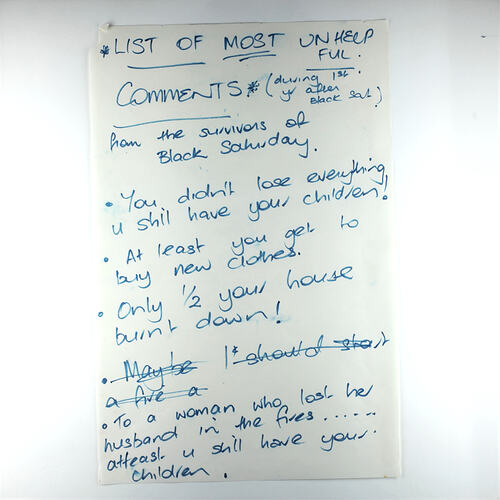Summary
This is a set of three posters which lists negative comments received by survivors in the year after the Black Saturday bushfires. These compiled comments, some well-intentioned, display the emotional challenges faced by survivors in rebuilding and the effects of dwindling public interest and empathy in the months after the fires.
The posters were on display in the Hurstbridge Relief Centre and aided the community in venting their frustration at the misunderstanding or minimisation of their traumatic experiences.
The Hurstbridge Relief Centre opened 2 to 3 weeks after Black Saturday to offer help and support to the firefighters and the community members. It was initially opened to feed CFA volunteer firefighters and then it naturally developed into a material aid centre for the local bushfire-affected community. After a short period, the Centre relocated to larger premises next door to the Hall. The Centre was managed by volunteers for 2 years. In comparison, most of the other relief centres in Arthurs Creek, St Andrews, etc., had closed by May-June 2009. Initially, the Centre was open 7 days a week, with approximately 30 people visiting daily. After 6 months its hours were reduced to business hours, 9am to 5pm, Monday to Friday.
The 2009 Victorian Bushfires began in late January and culminated on Black Saturday, 7 February. This remains Australia's most deadly natural disaster. 400 fires were recorded in over 100 locations across Victoria. 173 people were killed, and 414 were injured. Over 3,400 properties were destroyed or damaged. Over 10,000 km of fences were burnt and more than 11,000 farm animals were killed or injured. Nearly 430,000 hectares of land were razed, and more than 1 million native animals perished. In terms of Victoria's public lands over 287,000 hectares were burnt, including almost 100,000 hectares of national and state parks and reserves, and nearly 170,000 hectares of state forests and reserves.
This collection forms part of the Victorian Bushfires Collection. This large and diverse collection was established following Black Saturday and includes a multi-disciplinary collection of artefacts, images and stories to record the experience and impact of bushfires across Victoria's landscape, ecology and history.
The 2009 Victorian Bushfires began in late January and culminated on Black Saturday, 7 February. This remains Australia's most deadly natural disaster. 400 fires were recorded in over 100 locations across Victoria. 173 people were killed, 414 were injured. Over 3,400 properties were destroyed or damaged. Over 10,000 km of fences were burnt and more than 11,000 farm animals were killed or injured. Nearly 430,000 hectares of land were razed, and more than 1 million native animals perished. In terms of Victoria's public lands over 287,000 hectares was burnt, including almost 100,000 hectares of national and state parks and reserves, and nearly 170,000 hectares of state forests and reserves.
This collection forms part of the Victorian Bushfires Collection. This large and diverse collection was established following Black Saturday and includes a multi-disciplinary collection of artefacts, images and stories to record the experience and impact of bushfires across Victoria's landscape, ecology and history.
Physical Description
White paper with blue ink.
More Information
-
Collection Names
-
Collecting Areas
-
Date Created
-
Inscriptions
*LIST OF MOST UNHELPFUL / COMMENTS* (during 1st yr after Black Saturday) / from the survivors of / Black Saturday. / - You didn't lose everything / u still have your children! / - At least you get to / buy new clothes / - Only 1/2 your house / burnt down! / - To a woman who lost her / husband in the fires ...... / at least u still have your / children.
-
Classification
-
Category
-
Discipline
-
Type of item
-
Overall Dimensions
425 mm (Width), 280 mm (Height)
-
Keywords
Bushfires, Emergency Services, Rural Life, Natural Disasters, Black Saturday Bushfires, 2009




